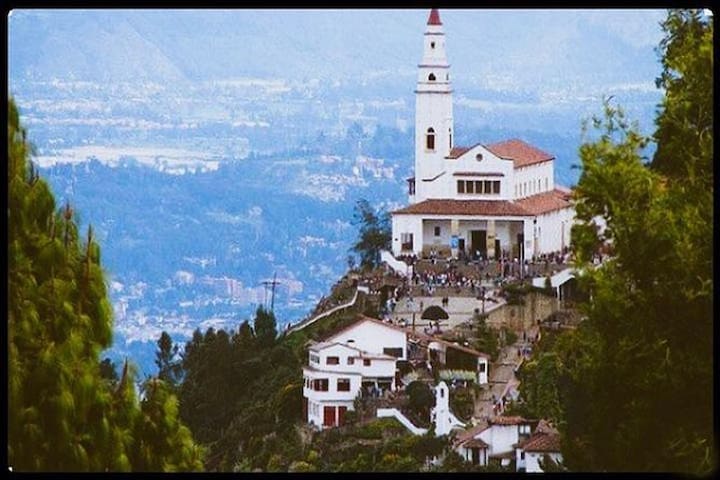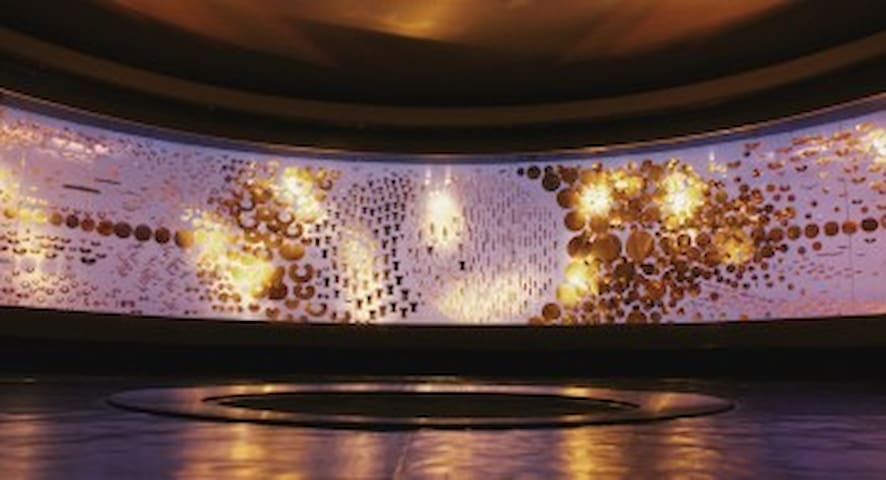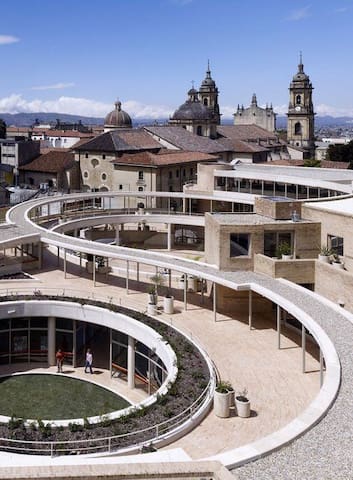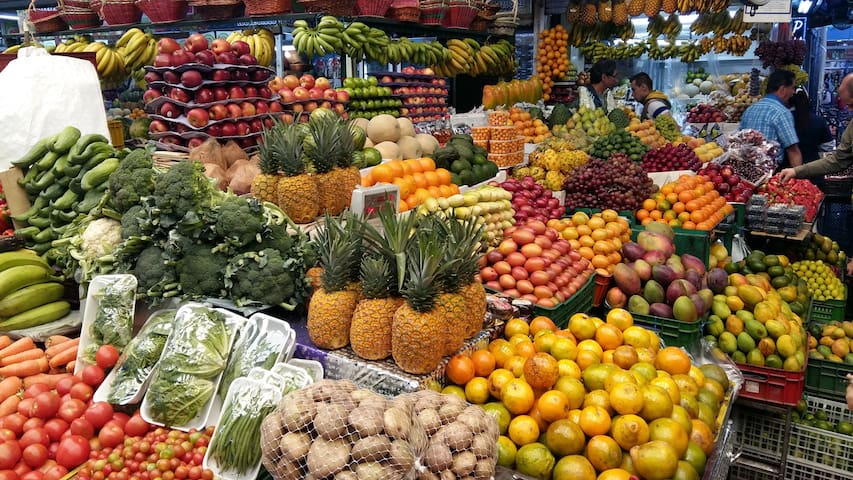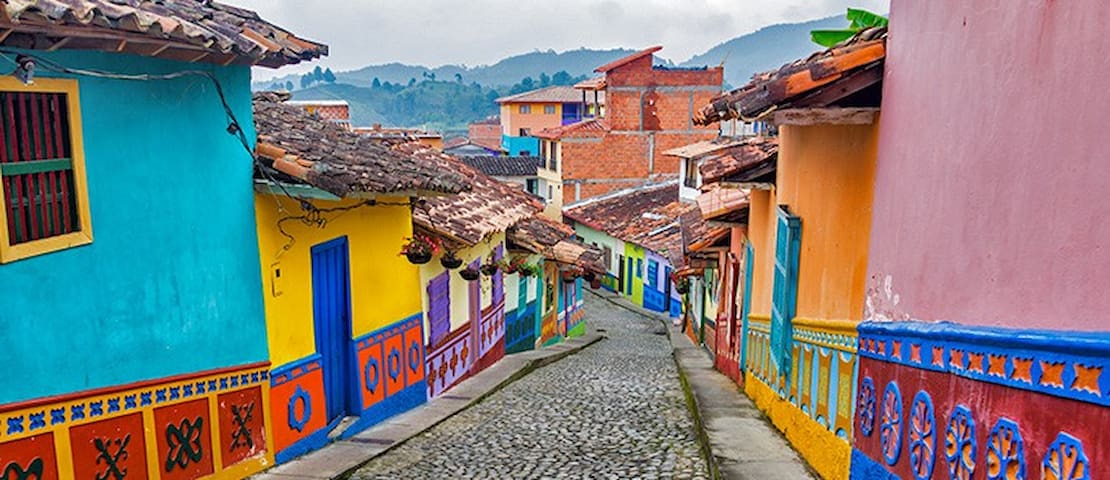Lugares de interés
The sanctuary of Monserrate in the eastern hills of Bogotá can be seen from almost anywhere in the city. It is located at 3,172 meters above sea level, at the top of Monserrate or Cerro de Las Nieves. Devotees walk up an almost two mile path to this traditional site of religious pilgrimage, which began in 1620 with the shrine of Our Lady of Monserrate. The basilica houses the image of the Fallen Lord of Monserrate, an effigy of Christ which, according to the faithful, performs miracles, and at the top visitors can walk the Stations of the Cross.
History of the most visited Sanctuary in Bogotá
The history of this sacred place dates back almost 500 years, when Bogotá was founded, and is now an icon of the city.
The mountain was originally named Cerro de Las Nieves, it was baptized by the Muiscas for its frequent cloudiness. Years later, a monastery dedicated to the Virgin of Montserrat was founded there, and a path was created from the church of Las Nieves to the top of the hill with small chapels for the pilgrims. The first religious festivity that had a pilgrimage to this hill was the festivity of the Holy Cross.
At the top of this hill is the shrine of the fallen Lord of Monserrate, made in 1640 by the artist Pedro de Lugo Albarracín. For many faithful Catholics, this statue of the Lord is miraculous and represents a special encounter with God. Hence why every weekend many Colombians and foreigners make the climb up the hill. Faith is the driving force behind why this place receives many visitors.
Building of the sanctuary was completed in 1920. It has a funicular and a cable car to bring visitors to the top, especially those who prefer to get there faster. However, the pedestrian path is ideal for enjoying nature, the vestiges of the indigenous path, exercising, browsing interesting handicrafts and interacting with the rich culture of this country.
Find out more: Religious tourism, holy Week in Mompox
How to get to the top of Monserrate?
Monserrate is located in downtown Bogotá, very close to the historic center of Bogotá, on Carrera 2da. Este No. 21 - 48, Paseo de Bolívar. If you want to climb the hill there are three options where you can enjoy a different beautiful view of the city, because on the way you can see the whole capital of Colombia.
Walk along the pedestrian path
If you want some exercise, have a penance or simply prefer to experience the hill on foot, you’ll have to take the opening and closing times of the Monserrate trail into account. It's open every day, except Tuesdays, from 5:00 am to 1:00 pm to go up and from 5:00 am to 4:00 pm to go down. Therefore, it's important to keep an estimate of your time there. The journey itself takes about 50 minutes to complete. This option is free of charge.
Going up in the funicular
If you prefer comfort, or for health reasons it's difficult to climb stairs, you can use the Monserrate funicular, which is open Monday to Friday from 6:30 am to 11:45 am and on Saturdays until 4:30 pm. The funicular ride comes at a cost of 12,000 COP one way and 21,000 COP two ways. On Sundays and holidays until 6:30 pm, it costs 6,500 COP one way and 12,000 COP two ways. However, if you are over 62 years of age, the cost for the two trips is 17,000 COP from Monday to Saturday, and on Sundays 10,000 COP, upon presentation of your identity card.
Getting on the cable car
Another perfect option for those who prefer to save time on the way up is the Monserrate cable car, which is open Monday to Saturday from 12:00 pm to 11:30 pm, at a cost of 12,000 COP one way and 21,000 COP two ways. On Sundays it opens from 10:00 am to 4:30 pm at a cost of 6,500 COP one way and 12,000 COP two ways. And if you want to go up with your pet, the rental costs 5.000 COP if it is small, and 10.000 COP if it is big.
What to do and see at Monserrate?
If you go up on foot, during the tour you will see a wide range of handicrafts, traditional food, sculptures of the stations of the cross and the chapel of the Virgin of Monserrat. If you go up by funicular or cable car, you will enjoy a beautiful view of the capital and the diversity of flora and fauna on the hill, where more than 80 species of birds live.
Once at the top of the hill there are several activities you can enjoy, such as the main tourist attraction, the Basilica Sanctuary of Monserrate. In this church you can admire beautiful sculptures from the colonial period, among them the important statue of the fallen Lord of Monserrate, which represents Jesus falling for the third time on his way to Calvary. It is said that it is miraculous, that its hair grows and when they try to lower it to the city, its weight increases, becoming an impossible task to achieve.
Behind the sanctuary, there is a large plaza with handicrafts or souvenirs, and next to it several restaurants where you can taste the most varied gastronomy of Bogota, from hot chocolate with tamale and bread to the famous rib broth, changua, ajiaco and much more. Also, adjacent to the Sanctuary, there are two traditional restaurants from the last century that have terraces overlooking the mountain and the city, where you can enjoy typical Colombian food and even international dishes.
At the top of Monserrate you’ll find beautiful gardens with breathtaking flower arrangements leading to the famous Well of Wishes, where you can make a wish by flipping a coin. Perhaps the most unforgettable feature here is, of course, the viewpoint, where you can take in the Cerro de Guadalupe, the best views of Bogota, picturesque sunsets and then appreciate the capital illuminated at night. You will surely not want to miss this spectacular view.
The First thing encountered by tourists who want to climb the hill of Monserrate is the cable car station and the funicular. It is a house remodelled in 1985 with architecture reminiscent of the colonial era and from where two cabins take passengers to the top. The tour takes about five minutes in the cable car.
1000 locals recommend
Monserrate
The sanctuary of Monserrate in the eastern hills of Bogotá can be seen from almost anywhere in the city. It is located at 3,172 meters above sea level, at the top of Monserrate or Cerro de Las Nieves. Devotees walk up an almost two mile path to this traditional site of religious pilgrimage, which began in 1620 with the shrine of Our Lady of Monserrate. The basilica houses the image of the Fallen Lord of Monserrate, an effigy of Christ which, according to the faithful, performs miracles, and at the top visitors can walk the Stations of the Cross.
History of the most visited Sanctuary in Bogotá
The history of this sacred place dates back almost 500 years, when Bogotá was founded, and is now an icon of the city.
The mountain was originally named Cerro de Las Nieves, it was baptized by the Muiscas for its frequent cloudiness. Years later, a monastery dedicated to the Virgin of Montserrat was founded there, and a path was created from the church of Las Nieves to the top of the hill with small chapels for the pilgrims. The first religious festivity that had a pilgrimage to this hill was the festivity of the Holy Cross.
At the top of this hill is the shrine of the fallen Lord of Monserrate, made in 1640 by the artist Pedro de Lugo Albarracín. For many faithful Catholics, this statue of the Lord is miraculous and represents a special encounter with God. Hence why every weekend many Colombians and foreigners make the climb up the hill. Faith is the driving force behind why this place receives many visitors.
Building of the sanctuary was completed in 1920. It has a funicular and a cable car to bring visitors to the top, especially those who prefer to get there faster. However, the pedestrian path is ideal for enjoying nature, the vestiges of the indigenous path, exercising, browsing interesting handicrafts and interacting with the rich culture of this country.
Find out more: Religious tourism, holy Week in Mompox
How to get to the top of Monserrate?
Monserrate is located in downtown Bogotá, very close to the historic center of Bogotá, on Carrera 2da. Este No. 21 - 48, Paseo de Bolívar. If you want to climb the hill there are three options where you can enjoy a different beautiful view of the city, because on the way you can see the whole capital of Colombia.
Walk along the pedestrian path
If you want some exercise, have a penance or simply prefer to experience the hill on foot, you’ll have to take the opening and closing times of the Monserrate trail into account. It's open every day, except Tuesdays, from 5:00 am to 1:00 pm to go up and from 5:00 am to 4:00 pm to go down. Therefore, it's important to keep an estimate of your time there. The journey itself takes about 50 minutes to complete. This option is free of charge.
Going up in the funicular
If you prefer comfort, or for health reasons it's difficult to climb stairs, you can use the Monserrate funicular, which is open Monday to Friday from 6:30 am to 11:45 am and on Saturdays until 4:30 pm. The funicular ride comes at a cost of 12,000 COP one way and 21,000 COP two ways. On Sundays and holidays until 6:30 pm, it costs 6,500 COP one way and 12,000 COP two ways. However, if you are over 62 years of age, the cost for the two trips is 17,000 COP from Monday to Saturday, and on Sundays 10,000 COP, upon presentation of your identity card.
Getting on the cable car
Another perfect option for those who prefer to save time on the way up is the Monserrate cable car, which is open Monday to Saturday from 12:00 pm to 11:30 pm, at a cost of 12,000 COP one way and 21,000 COP two ways. On Sundays it opens from 10:00 am to 4:30 pm at a cost of 6,500 COP one way and 12,000 COP two ways. And if you want to go up with your pet, the rental costs 5.000 COP if it is small, and 10.000 COP if it is big.
What to do and see at Monserrate?
If you go up on foot, during the tour you will see a wide range of handicrafts, traditional food, sculptures of the stations of the cross and the chapel of the Virgin of Monserrat. If you go up by funicular or cable car, you will enjoy a beautiful view of the capital and the diversity of flora and fauna on the hill, where more than 80 species of birds live.
Once at the top of the hill there are several activities you can enjoy, such as the main tourist attraction, the Basilica Sanctuary of Monserrate. In this church you can admire beautiful sculptures from the colonial period, among them the important statue of the fallen Lord of Monserrate, which represents Jesus falling for the third time on his way to Calvary. It is said that it is miraculous, that its hair grows and when they try to lower it to the city, its weight increases, becoming an impossible task to achieve.
Behind the sanctuary, there is a large plaza with handicrafts or souvenirs, and next to it several restaurants where you can taste the most varied gastronomy of Bogota, from hot chocolate with tamale and bread to the famous rib broth, changua, ajiaco and much more. Also, adjacent to the Sanctuary, there are two traditional restaurants from the last century that have terraces overlooking the mountain and the city, where you can enjoy typical Colombian food and even international dishes.
At the top of Monserrate you’ll find beautiful gardens with breathtaking flower arrangements leading to the famous Well of Wishes, where you can make a wish by flipping a coin. Perhaps the most unforgettable feature here is, of course, the viewpoint, where you can take in the Cerro de Guadalupe, the best views of Bogota, picturesque sunsets and then appreciate the capital illuminated at night. You will surely not want to miss this spectacular view.
The First thing encountered by tourists who want to climb the hill of Monserrate is the cable car station and the funicular. It is a house remodelled in 1985 with architecture reminiscent of the colonial era and from where two cabins take passengers to the top. The tour takes about five minutes in the cable car.
In the heart of Bogotá, the extraordinary Gold Museum will astound you with the largest collection of prehispanic goldwork in the whole world.
It's such a special place that, in 2018, National Geographic magazine named it one of the best museums in the history of the planet, next to the Auschwitz-Birkenau Memorial and Museum (Poland), the Vatican museums (Italy), and the Pergamon Museum, amount others.
The museum has 34,000 gold pieces, each of which has its own incomparable beauty and historic value. Many of these items were used in the daily life or sacred rituals of indigenous peoples like the muisca and tayrona.
Among the museum's many gold pieces, you'll find the iconic poporo quimbaya, a vessel used by indigenous cultures to store lime for their ritualistic chewing of coca leaves.
Thanks to its balanced proportions and the advanced techniques used to make it, the poporo quimbaya has become famous and is now an important part of Colombian cultural identity.
You may be interested: Five Reasons to Take a Graffiti Tour in Bogota
Discover The "El Dorado" Legend
Extraordinary Muisca piece, one of the 34.000 astonishing gold pieces of The Gold Museum
One of the 34.000 astonishing gold pieces of The Gold Museum.
Another absolutely stunning piece is the Muisca Raft, which portrays the ritual that brought about the famous legend of El Dorado.
Legend says that there was once a place in the South American continent where everything was made of gold. Many 16th-century Europeans, obsessed with the legend of El Dorado, traveled great distances searching for its hidden treasures.
Of course, they never did find it. However, they did find many indigenous chieftains adorned with nose rings, breastplates, and other metal accessories.
They also heard rumors about a chieftain so rich that he used gold powder to adorn himself in place of baubles. It was said that he shone like the sun.
This legendary, gold-coated chieftain who sailed a raft to the center of a lake, was the one from Guatavita. And that, it seems, was the El Dorado sought for so desperately by explorers, and so masterfully represented in the Muisca Raft gold figure that you can view in the Gold Museum.
The museum is open Tuesday to Saturday from 9am to 6pm, and on Sundays from 10am to 4pm. Touring the whole museum will take about four hours. Remember that all of the exhibits are in English and Spanish, and that you can rent an audio tour that will help you delve deeper into the remarkable histories of these indigenous groups.
Visit the Gold Museum—don't miss out on your opportunity to learn about these stunningly brilliant pieces of Colombian history. CLOSED EVERY MONDAY
901 locals recommend
Gold Museum (Museo del Oro)
15-88 Cra. 6In the heart of Bogotá, the extraordinary Gold Museum will astound you with the largest collection of prehispanic goldwork in the whole world.
It's such a special place that, in 2018, National Geographic magazine named it one of the best museums in the history of the planet, next to the Auschwitz-Birkenau Memorial and Museum (Poland), the Vatican museums (Italy), and the Pergamon Museum, amount others.
The museum has 34,000 gold pieces, each of which has its own incomparable beauty and historic value. Many of these items were used in the daily life or sacred rituals of indigenous peoples like the muisca and tayrona.
Among the museum's many gold pieces, you'll find the iconic poporo quimbaya, a vessel used by indigenous cultures to store lime for their ritualistic chewing of coca leaves.
Thanks to its balanced proportions and the advanced techniques used to make it, the poporo quimbaya has become famous and is now an important part of Colombian cultural identity.
You may be interested: Five Reasons to Take a Graffiti Tour in Bogota
Discover The "El Dorado" Legend
Extraordinary Muisca piece, one of the 34.000 astonishing gold pieces of The Gold Museum
One of the 34.000 astonishing gold pieces of The Gold Museum.
Another absolutely stunning piece is the Muisca Raft, which portrays the ritual that brought about the famous legend of El Dorado.
Legend says that there was once a place in the South American continent where everything was made of gold. Many 16th-century Europeans, obsessed with the legend of El Dorado, traveled great distances searching for its hidden treasures.
Of course, they never did find it. However, they did find many indigenous chieftains adorned with nose rings, breastplates, and other metal accessories.
They also heard rumors about a chieftain so rich that he used gold powder to adorn himself in place of baubles. It was said that he shone like the sun.
This legendary, gold-coated chieftain who sailed a raft to the center of a lake, was the one from Guatavita. And that, it seems, was the El Dorado sought for so desperately by explorers, and so masterfully represented in the Muisca Raft gold figure that you can view in the Gold Museum.
The museum is open Tuesday to Saturday from 9am to 6pm, and on Sundays from 10am to 4pm. Touring the whole museum will take about four hours. Remember that all of the exhibits are in English and Spanish, and that you can rent an audio tour that will help you delve deeper into the remarkable histories of these indigenous groups.
Visit the Gold Museum—don't miss out on your opportunity to learn about these stunningly brilliant pieces of Colombian history. CLOSED EVERY MONDAY
A central outdoor plaza and brick and concrete structure represent the vision of Rogelio Salmona, architect of the Gabriel García Márquez Cultural Center. In this part of La Candelaria in downtown Bogotá, visitors will find the headquarters of the Mexican publisher Fondo de Cultura Economica, an auditorium for 324 people, and an exhibition hall, among other things.
50 locals recommend
Centro Cultural Gabriel Garcia Marquez
##5-60 Cl. 11A central outdoor plaza and brick and concrete structure represent the vision of Rogelio Salmona, architect of the Gabriel García Márquez Cultural Center. In this part of La Candelaria in downtown Bogotá, visitors will find the headquarters of the Mexican publisher Fondo de Cultura Economica, an auditorium for 324 people, and an exhibition hall, among other things.
The Virgilio Barco Library is housed in a circular brick structure surrounded by multiple bodies of water. It was designed by architect Rogelio Salmona, who was born in Paris in 1929 but was always considered to be Colombian. The building houses, among other things, a collection of 150,000 volumes, reference and specialty rooms, and an auditorium with a capacity for 350 people.
127 locals recommend
Biblioteca Virgilio
The Virgilio Barco Library is housed in a circular brick structure surrounded by multiple bodies of water. It was designed by architect Rogelio Salmona, who was born in Paris in 1929 but was always considered to be Colombian. The building houses, among other things, a collection of 150,000 volumes, reference and specialty rooms, and an auditorium with a capacity for 350 people.
Gastronomía
Lets start reminding Colombia is the #2 Biodiverse country on the planet. Now, Paloquemao Square, in the west of Bogotá, is a traditional part of the city where fresh vegetables and other farm products fill an old abandoned railroad warehouse with color. The square, in operation since 1972, is much more than a marketplace, and attracts Colombian and foreign visitors who find a wide variety of fruit.
63 locals recommend
Paloquemao
25-04 Av. Cdad. de LimaLets start reminding Colombia is the #2 Biodiverse country on the planet. Now, Paloquemao Square, in the west of Bogotá, is a traditional part of the city where fresh vegetables and other farm products fill an old abandoned railroad warehouse with color. The square, in operation since 1972, is much more than a marketplace, and attracts Colombian and foreign visitors who find a wide variety of fruit.
Vecindarios
Give yourself up to its unique streets. Many of the buildings of the La Candelaria neighborhood, the majority of which were built in colonial and Republican-era styles, have been declared properties of historical and cultural interest. There are around 500 artistic institutions or groups, museums, research centers, theaters, libraries, and universities in this area of the historical center of Bogotá. Also a local gastronomic hub.
584 locals recommend
Greann Candelaria
6-58 Cl. 12bGive yourself up to its unique streets. Many of the buildings of the La Candelaria neighborhood, the majority of which were built in colonial and Republican-era styles, have been declared properties of historical and cultural interest. There are around 500 artistic institutions or groups, museums, research centers, theaters, libraries, and universities in this area of the historical center of Bogotá. Also a local gastronomic hub.

